- Scott Mckeating
- Albums and Singles
The first untitled cut opens with a Bjorkian weave of melodies, the chimes and pulped sounds giving the album a Jekyll-and-Hyde vibe: the beauty charred by other half's hazard. Basalt Fingers offer up the soft white underbelly of math rock, slicing and massaging it into tones and optimistic grumbling guitar sounds. Both cuts feel more devotional than their limited Gashound debut, they sound like they were recorded in a church carved out like a wet pumpkin. Sounds can soak into surfaces or come up off them like sparking wires, at times it appears to be straight amp feedback or a snakey organ melody rather than manipulated guitars. Sines spiral up and around like maddening carnival anthems heard through rotted tenement floors.
There is more of a structure to the second track, a mobius melody that festers (but in a good way). Conjecture over who is playing what is short-lived, the three constituent parts matching the styles of the players. The high end out-of-head soloing seems incredibly Chasny-like, the bassy mud very close to Mouthus' trudge and the organ pitches like Ambrogio's hard-to-pin-down playing. All in all, this track is more choppy and sunken than anything they have released so far.
Read More
- Creaig Dunton
- Albums and Singles
The tracks are almost pared off in style, with the midpoint being the most different of the bunch. Opening "Composition B" and ending track "A_" are built around digitally tweaked guitar tones, bass heavy rumbles that could almost be a nod to Earth, and clearer, more pure strums. Although organic at the core, both tracks have a digital sheen to them in the form of glitchy stutters and fragmented bits of voice.
"P." and "N," on the other hand, are stripped down minimal piano affairs. In the tradition of folks like John Cage, the tracks are more about the space between the sounds rather than the piano notes themselves: the notes are allowed to reverberate through space and draw attention to the quiet moments. The middle piece, "E/R," is digitally synthesized tones and glitches that slowly build, layer upon layer, until it is a thick mix of musical fragmented data that, in spite of its digital nature, has a warmth to it.
Clocking in at barely 20 minutes, S. is an interesting little bit of an EP that isn't the esoteric sort of experimentation that could be expected, but instead is a fascinating selection of tracks that have made me want to dig more into Chauveau's discography.
Read More
- Administrator
- Albums and Singles
 This was easily one of the most striking and visceral albums that I encountered last year, but it has somehow remained mostly under the radar.  Cold Pin is the end-product of a two-year labor of love, as Keszler leads an excellent ensemble in a very unique collaboration with a huge string installation that he built in a large dome in Boston (the Cyclorama).  It's an amazing and unusual performance, but the installation itself could probably have a very successful career as a solo artist: few things sound better than giant strings being scraped at by small motors in a cavernous room with great acoustics.
This was easily one of the most striking and visceral albums that I encountered last year, but it has somehow remained mostly under the radar.  Cold Pin is the end-product of a two-year labor of love, as Keszler leads an excellent ensemble in a very unique collaboration with a huge string installation that he built in a large dome in Boston (the Cyclorama).  It's an amazing and unusual performance, but the installation itself could probably have a very successful career as a solo artist: few things sound better than giant strings being scraped at by small motors in a cavernous room with great acoustics.
This album consists of two side-long performances, each clocking in at just under 15 minutes.  That may seem brief, but it is actually the perfect length for music as texture-centered as this.  The primary difference between the two pieces is that in "Cold Pin 2," the motors percussively attack metal squares in addition to the strings.  It is nearly impossible to tell which sounds are coming from the squares and which are coming from the Keszler's wild, skittering drumming without actually being there though, as man and machine blur together quite seamlessly.
Of the two pieces, I prefer "Cold Pin 1," simply because the creaking and scraping strings are more prominent and active.Those strings are honestly more than enough to carry the piece on their own, as the deep metallic scraping and humming is extremely engrossing and feels almost tactile.  Both pieces have a rumbling, physical presence that is both massive and mesmerizing.  Notably, the longest string that Keszler used is only 25 feet, which makes me wonder how shudderingly apocalyptic his previous water basin installation in Shreveport was (which used 200 ft. strings) or whether his planned future installation with 2000 ft. strings will cause an earthquake
Aside from creating an extremely cool sound installation that translates quite well into album form (a rare feat indeed), Keszler managed to also impress me as both a drummer and a composer.  His drumming is nearly as prominent as the massive thrumming strings and provides a perfect counterbalance to their slow-motion immensity, as he plays very unconventionally and with a curiously muted ferocity.  I have no idea what the hell he is doing or how he is doing it (I think he has some mechanical help), but he somehow manages to sound like a thousand pencils falling down a metal staircase.  Conversely, the actual composition is about as far from busy or flashy as possible–Keszler uses his talented battery of musicians both sparingly and droningly.  No one ever plays anything remotely conventional or melodic.  Instead, the trumpet, woodwinds, and guitars all seem to wax and wane together like a single undulating organic entity, creating a queasily brooding atmosphere rather than competing for my attention.
I could not be more impressed with this album, as Keszler and his collaborators not only do everything right, but manage to do it right in ways that I could not have anticipated.  Obviously, any piece focused so intently on things like natural reverberation, decay, and the sound of metal scraping metal is going to be a pretty challenging listen, but Cold Pin is heavy and unpredictable enough to be instantly engaging.  This is not austere, concept-heavy sound art: this is a vibrantly buzzing, grinding, and clattering sound world.
Samples:
 
 
Read More
- Administrator
- Albums and Singles
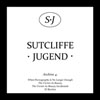 Heralding another spurt of activity, this legendary duo has reissued a pair of two long out of print albums from the late 1990s with two added discs of unreleased material. I’ve always found the two previously released albums, When Pornography is No Longer Enough and The Victim as Beauty, amongst the most unhinged and violent power electronics recordings ever, and they’ve lost none of their De Sadeian intensity since release.
Heralding another spurt of activity, this legendary duo has reissued a pair of two long out of print albums from the late 1990s with two added discs of unreleased material. I’ve always found the two previously released albums, When Pornography is No Longer Enough and The Victim as Beauty, amongst the most unhinged and violent power electronics recordings ever, and they’ve lost none of their De Sadeian intensity since release.
Originally the solo project of Kevin Tomkins in the early 1980s, he first shelved the SJ name after joining Whitehouse, but later returned to it with Paul Taylor in the mid 1990s with the guitar-heavy Death Mask.A few years later When Pornography is No Longer Enough appeared on the short lived Death Factory side-label of Cold Meat Industries.
The core of this box is a pair of concept albums, based around the life and crimes of fictional murderer Hyndo Carney.I've always had my reservations about noise/power electronics and the whole "misogynistic serial killer" theme, but SJ does it so well that it's hard to criticize.It was at this point that the identifiable guitars from Death Mask disappeared, replaced with inconsistent, acidic blasts of noise that sounds like no one else.Coupled with Tomkins' completely unhinged vocals, there is a level of mania that hardly anything can match.
At the same time as this album was recorded, Tomkins and Taylor were also working on the final Bodychoke album, Cold River Songs, which was, ironically, their most accessible work.While the sonic approach between the two albums may have been completely different, some overlap can be heard: "Third Victim: With Control: Message to Your Mother" shares many lyrics with that album's opener "Control", but here amped up to even greater levels of disgusting brutality.Even though most of the album is spastic outbursts of vocals and jarring white noise, the title track instead has a carefully composed structure, building a hellish blast from rudimentary sounds.As a whole the album never relents, save for a dark ambient outro to "Seventh Victim", which still leaves on a painful note.
The second album, The Victim as Beauty, covers similar ground, but is more conceptually structured, mimicking a traditional narrative.While the harsh pieces are in a similar vein to Pornography, there is more of a cinematic atmosphere, with the more violent moments tempered with pensive, ambient passages that give some relief, but the tension never relents.
The harsher noise pieces are very similar to the previous album, but also show that SJ couldn't push this level of intensity any further.For example, Tomkins' "Come on, cunt…show me your fucking titties!" line almost pushes the album into self-parody on opener "Act One: Abduction"
It almost seems as if Tomkins and Taylor figured this out early on, because the album develops an identity of its own afterward.The second "scene," "Act I:Fear and Anticipation," is a repetitive loop of what sounds like organ music allowing only the most subtle of variations, creating a vintage horror flick ambient tension that threatens to attack at any given time. The noise pieces, like "Humiliation"display the same harsh vibes as Pornography, but it comes across as more structured, less manic in comparison.Ending "Cold Aftermath" is a simple expanse of droning synth, with clattering distant percussive outbursts.
Disc three is unreleased material from The Victim as Beauty sessions, different experiments in sound that vary greatly from the harsh moments of that album but also herald some of the more recent SJ output, as well as Tomkins’ solo work."Realisation" and "First Blood," for example, are heavily processed loop-centric works that inhabit that purgatory between noise and ambience, a place that SJ threw themselves into with This Is The Truth.
It's only "White Light Power" that feels like the band's traditional noise, and with its overdriven, but sustained passages of mangled sound, it could almost be an early SJ work that never saw the light of day.Overall the pieces on the disc do reinforce the cinematic concept of The Victim as Beauty, and would probably have strengthened that album even more:the shrill scrapes of "Final Victim" and the cold electronic dissonance of "Post" could easily pass for film score material.
The fourth disc includes the previously released XI 7" single, which has a substantially difference sound than what proceeded it, such as the collaged restraint of "V," even with its noise outbursts, and the old fashioned power electronics squall of "VI."Also included are two tracks that were considered for single release, but abandoned."Drowning in the Glorious Bloody Filth" encroaches surprisingly into musical territory, with overdriven synth loops and Tomkins' actually singing (and sounding very Genesis P-Orridge like).Its counterpart is "Cunt Down (Eyes Please Mother)" with its unrelenting white noise ambience comes across as a precursor to the whole "harsh noise walls" scene.
When Sutcliffe Jugend began to reinvent their sound in the mid 2000s, it was a necessary evolution.The whole harsh noise/power electronics aggression hit a zenith which would be nearly impossible to reach again:sound and music doesn't get more violent than this.Even over a decade since they first appeared, these albums are still unmatched, and the supplemental material included gives a new insight into both these albums and the band.Disturbing, ugly and unpleasant are fair adjectives for this violent material, which is what makes it so brilliant, and a cursory listen shows just how much influence these albums have had:I doubt Prurient would be around had these guys not done their thing first.
samples:
- First Victim: With Knife: Left to Die with Many Cuts
- First Blood
- Drowning in the Glorious Bloody Filth
 
Read More
- Administrator
- Albums and Singles
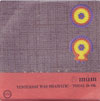 I'mnot sure why it took me so long to discover Múm: the records havealways been available and they've toured through these partsand received rave reviews and comparisons to lots of music that Ilike, so it would seem natural that I'd have picked up a couple of Múmrecords by now, but not so.
I'mnot sure why it took me so long to discover Múm: the records havealways been available and they've toured through these partsand received rave reviews and comparisons to lots of music that Ilike, so it would seem natural that I'd have picked up a couple of Múmrecords by now, but not so. Morr Music
I'm happy Morr Music reissued Múm's debut full-length and that I've got a lull in theschedule where I can finally catch up with a group that deserves the attention. Listening to Yesterday Was Dramatic in avacuum of Múm knowledge, and perhaps baggage, it's easy to appreciatewhat the group is doing with a simple design. The songs here are earthyand natural despite being obviously digital in many ways, and when Ithink back to the year (2000) that this album was originally released,I can see how it predicted a lot of the folktronica and bedroom laptopmusic that's come out in the time since. There's a nice bridge herebetween the synthetic and odd-but-real world that makes the songs alittle familiar and a little alien at the same time.
Stylisticdescriptions aside, Múm's first record is perhaps best described as'cute,' an adjective that I don't find myself using very often, but onethat seems completely appropriate for Múm's distinctly childlikeapproach to music. So much of the music that works from this same potof sounds seems drowned in its own melancholy or created as a personaltherapy activity, but Múm is something altogether different. There's achildlike wonder at the magic of music on display in tracks like "Thereis a number of small things" and even the more somber tracks like "Theballad of the broken string" seem almost playful. I imagine the membersof Múm sitting around and asking one another "can you play theaccordian?" "No, can you?" and then just picking the thing up to seewhat it can do. The winding of music boxes, the whistle of toy flutes,and the digital cut up and manipulation of everything adds up to awonderfully experimental bit of exploration.
As breathy vocalstake the stage on "The ballad of the broken birdie records" the recordmomentarily stretches past my patience for cuteness and gets a littletoo precious for my tastes. I've heard that other people have had asimilar reaction to later Múm material, but for this record which isfive years old but new to me, and newly remastered, Múm's work isenchanting.
samples:
Read More
- Administrator
- Albums and Singles
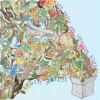 Thiswhole album is relaxing and feels warm through every listen. If theidea of being on an island or on a beach isn't appealing, then imaginesitting on a dock and fishing somewhere with nobody around—only thesound of crickets or the call of different birds all throughout theday—the water would pass slowly by and even the most pressing matterswould slip away with it.
Thiswhole album is relaxing and feels warm through every listen. If theidea of being on an island or on a beach isn't appealing, then imaginesitting on a dock and fishing somewhere with nobody around—only thesound of crickets or the call of different birds all throughout theday—the water would pass slowly by and even the most pressing matterswould slip away with it.Paquet Surpriseis a mostly quiet album. Not that I ever had to turn the album up tohear all the sounds, but all the songs bleed a quiet gentleness. Evenwhen a distorted line of garbage interrupts the soft singing on "I AmWaiting (For December)," there's a sense that it belongs in that placejust as naturally as all the other, quieter sounds. Seconds pass bysizzling with Davis' own peculiar warmth, a result of his approach todigital editing and composition I suppose, but also present is Roux'sdelicate touch.
Though Davis' Somnia was melodic in its ownright, there's far more melody present on every song than I wouldexpect from a record Davis might compose on his own. Roux's additionsstrike me as being harmonious with Davis'. I understand theysent their music back and forth and, as such, both their signatures aregoing to be present in the music, but every song is so fully satisfyingand lively that I have to attribute some of its appeal to how wellthese two work together.
The cover of Paquet Surprise depictsall manner of animals and flora being stuffed into a tiny box; theimage is a perfect parallel for the album's distinct flow and generallygentle sound. Fluttering computer talk, instruments, and fieldrecordings all bump into each other, flowering and decomposing as theyintertwine and generate moments of melody, rhythm, and chaos. At timesthe jumble of electronic stuff will get overwhelming, but slowly bereplaced by the shake of a rattle and the ring of a guitar and, beforelong, a "song" in the classical sense of the word will emerge briefly.It's only succumbed by Davis' and Roux's massively low sound, but thosebrief interludes are lovely and only adds to the generally attractivenature of the entire record.
At one point the sounds of the ocean washup over a percolating digital swarm and there's a sense that I might bein paradise somewhere, resting on the beach with a beer in one hand anda book in the other. By the end of the album I've realized that thewhole time Davis and Roux have been building this atmosphere, thiseuphoria of a paradise in my bedroom. The tropical, sunny dispositionof each song is enough to make winter seem unbearable, but at leastthere's this album. Warm waters, sunny beaches, green trails...everything's just been packed up and stuffed inside these songs for theseason. It's enough to want to hear Davis and Roux do somethingtogether again, though I doubt it'll happen.
Davis has been a part ofseveral collaborations this year and with that in mind, it is likelythat he'll just move on and continue to change his sound along with hisconspirators. Sebastien Roux has a record available right now onApestaartje and I imagine, from the merits of his work on thisrecording, that his solo material is worth a listen, too.
samples:
Read More
- Administrator
- Albums and Singles
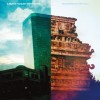 After a full year off from touring and releasing new music, A Place to Bury Strangers are still going strong with their balance of sharp hooks and sonic firepower. Much like the Jesus and Mary Chain's significant leap in fidelity from Psychocandy to Darklands, this five-song EP will likely generate more discussion about its production and mixing choices than its well-constructed tunes.
After a full year off from touring and releasing new music, A Place to Bury Strangers are still going strong with their balance of sharp hooks and sonic firepower. Much like the Jesus and Mary Chain's significant leap in fidelity from Psychocandy to Darklands, this five-song EP will likely generate more discussion about its production and mixing choices than its well-constructed tunes.
Onwards to the Wall signals a few significant changes for A Place to Bury Strangers; their move to a different label, Dead Oceans, is an obvious one. More significantly, though, APTBS have taken a step back from the full-frontal guitar maelstrom that has come to define their music, and toward a sort of traditionally hooky, guitar-based rock (still with a bite, of course) readying itself to thrive on the strength of its songwriting. While no more or less catchy than much of their previous work—several cuts from their debut still rank among their most hummable—the de-emphasis on having Oliver Ackermann's guitar at the forefront, cranked into the red at 110% capacity, makes it easier to focus on the songs at hand.
The most memorable moment on this EP is influenced by an addition to the band's core lineup: bassist and vocalist Dion Lunadon provides Ackermann with a foil, and a second voice, to play with in his songs. The title track deploys a call-and-response, boy/girl vocal structure—one of the oldest tricks in the pop songwriting book, right, Nancy and Lee?—fitted within a tense, echo- and feedback-laden framework that builds tension and tempo, with no easy release. Elsewhere, "I Lost You" harkens back to the debut, with its insistent pace and drum machine-esque rhythm section, though Ackermann's guitar is cranked down a few notches from "obliterate" to "incinerate." The most volatile song here is "Nothing Will Surprise Me," which crams an ungodly amount of pitch-shifted, tremolo'd guitar work into three short minutes. "Drill It Up" closes the set with fuzzed-out bass guitar and the industrial clank of the percussion leading the charge.
I'm guessing that Ackermann & Co. will absolutely tear these songs to shreds in a live setting, and at home, the production is solid enough to allow Onwards to the Wall to be cranked up to ear-splitting volumes and sound full of life. Sure, the guitars are set backward in the mix, but things still get fucking loud with a simple turn of the volume dial. The balance has shifted, and it's to the band's credit that they are no longer a walking advertisement for Death by Audio, Ackermann's day job building effect pedals (you gotta admit, the title of Ackermann's first pedal, "Total Sonic Annihilation," was a spot-on characterization of APTBS circa 2007). Instead, Onwards to the Wall sees the band evolving, making smart adjustments to their sound before their next full-length, instead of treading water and repeating their past work.
Samples:
Read More
- Administrator
- Albums and Singles
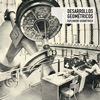 I didn't know quite what to expect from a new Esplendor Geométrico album, aside from a lot of relentlessly repeating percussion loops.  However, I did know that I didn't expect Desarrollos Geométricos to be nearly as distorted and brutal as it is, as their last few studio albums have been comparatively clean and less-hostile.  In many respects, this surprise return to the fury of their youth is pretty striking and invigorating, but this Spanish duo still has yet to shake some of their more fundamental and recurring flaws.
I didn't know quite what to expect from a new Esplendor Geométrico album, aside from a lot of relentlessly repeating percussion loops.  However, I did know that I didn't expect Desarrollos Geométricos to be nearly as distorted and brutal as it is, as their last few studio albums have been comparatively clean and less-hostile.  In many respects, this surprise return to the fury of their youth is pretty striking and invigorating, but this Spanish duo still has yet to shake some of their more fundamental and recurring flaws.
Few artists are as unapologetically single-minded in their focus as Esplendor Geométrico, as Arturo Lanz and his varying bandmates have now spent three decades chasing the perfect beat to the exclusion of nearly everything else.  In fact, a near-obsessive fixation on rhythm is basically the sole recurring theme that defines EG's work.  Well, that and extreme volume–this, like most other EG albums, is meant to be played as loudly as possible.  That is both a blessing and a curse.  These are the sort of crushing, building-shaking beats that could completely entrance and consume me when played at jet-engine volume levels live, but their brutal simplicity often leaves a lot to be desired in a normal listening environment.  The actual "music" often feels quite half-hearted and tossed-off.  Also, Lanz and Saverio Evangelista sometimes display a very primitive and puzzling "shock" aesthetic with their samples that seems better left in the '80s.
That tactic arguably works with "Presión" though, which features a snippet of an anguished woman shrieking "call 911 now," but it only succeeds because she sounds so unhinged that it feels more like a threat than a cry for help.  It sounds like she is about to tear someone's goddamn face off with her bare hands, which unsurprisingly still seems quite powerful despite being wildly over-the-top.  Dramatically less successful, however, is "Criba mecánica," which artlessly incorporates a bunch of porn samples.  Few things are more embarrassing or uncomfortable than a clumsy attempt to be puerile or darkly sexual.  That musical crime is doubly frustrating in this particular instance, as the throbbing mechanized beat and dissonant feedback beneath the moans and whimpers is pretty awesomely menacing and dystopian-sounding.  Fortunately, that dubious piece is omitted entirely from the vinyl version of the album and the remainder of the songs eschew any similarly gauche or ill-advised loops.
Tellingly, the strongest songs on Desarrollos Geométricos don't offer many frills at all, just insistent bludgeoning with machine-like precision.  My favorite is "Cada día más," which stomps and crunches along for four-and-half-minutes with little more than an eerie hum and some panning tricks to augment the unrelenting pulse.  In most cases, however, these songs could benefit greatly from even the slightest nod towards conventional musicality.  I'm not delusional–I don't expect anything crazy like actual songs or dynamic variation from Lanz, but it seems EG invariably errs either on the side of adding practically nothing to their beats or adds something far too brazen, distracting, and attention-stealing.  I'm sure there is a middle ground somewhere that Arturo and Saverio could find that might elevate their work into something less niche.  I wish they'd look for it.
It is undeniably a bit frustrating to see that Lanz and Evangelista are just as inconsistent and incapable of fully realizing the raw potential of their work as ever.  However, it is also quite heartening to see them return to abrasive roots with such enthusiasm and raw power.  Esplendor Geométrico are still definitely at the top of their game as far as constructing huge, hypnotic, and ingeniously textured rhythms: there is no one else I'd rather have playing if I was throwing an orgiastic Industrial dance party in an abandoned aircraft hangar.  I just wish they'd figure out a way to make their music as rewarding in other contexts.
(Note- the CD and vinyl versions of this album have radically different track listings.  Six of the nine songs on the CD are not on the vinyl release and three of the six songs on the vinyl are not on the CD.  This is a review of the CD version.)
Samples:
 
Read More
- Administrator
- Albums and Singles
*SKURA ~ Complete Works, 2005-2011, Book + DVD-R
2nd Edition : 2nd February, 2012
*SKURA comprises the artist's complete musical works published through Sustain-Release: 20 albums, 93 tracks, over 12 hours of music.
Previously available as a highly limited 20-disc set, *SKURA is now available as a collection of high quality, 320kbps MP3's on a single DVD-R. This edition is accompanied by a 122-page book featuring a full discography, artwork, poem fragments, liner notes and introductory essays by The Wire's Tony Herrington and Mojo's Andrew Male. Each copy is signed by the artist.
More information is available here.

Read More
- Administrator
- Albums and Singles
 Young God Records has announced the release of a new live Swans album We Rose From Your Bed With The Sun In Our Head, a 2 CD set.
Young God Records has announced the release of a new live Swans album We Rose From Your Bed With The Sun In Our Head, a 2 CD set.
We Rose From Your Bed With The Sun In Our Head is Handmade and Assembled With 2 Color Woodblock Print Sleeve of Original Drawing by M.Gira. Each One Uniquely Signed and Numbered and Further Personalized by M.Gira.
This Version is a Limited Edition of 1000 and includes Exclusive Solo Recordings of Songs for New Swans. Album in Progress (as well as narrations/explanations re the new songs, exclusive to this version).
|
|
|||
|
|||
|
|||
TRACK LISTING:
disc one: 1. intro/no words no thoughts 2. jim 3. beautiful child 4. the apostate 5. yr property 6. sex god sex
disc two: 1. the seer (intro)/ i crawled 2. eden prison 3. 93 ave. b blues / little mouth... demos/special website only recordings: 4. hello there 5. lunacy 6. the mother of the world 7. the daughter brings the water 8. a piece of the sky 9. the seer 10. goodbye.
SWANS: michael gira - guitar, vocal; norman westerg - guitar; phil puleo - drums, duclimer; thor harris - drums/percussion, vibes, clarinet, melodica, violin; christoph hahn - double lap steel guitar; christopher pravdica - bass.
http://www.younggodrecords.com/home/handmade-live-cd-bundle
Read More
- Administrator
- Albums and Singles
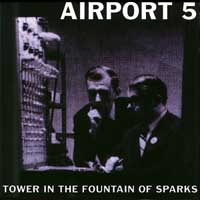 #15 in the Fading Captain Series, this release from Airport 5 is thefirst LP Rob Pollard has recorded with Tobin Sprout since the latterleft Guided By Voices to focus on his solo career. Given those keypieces of information, one could probably form a pretty solidpreconception about the sound of this record and what they might findwhen listening to it. Let's face it: Pollard is one of those artiststhat you either love or despise. So those who don't Like any ofPollard's music with Guided By Voices or the plethora of other bandshe's in, skip right over this review. The other camp will be happy toknow that these two artists still make magic together, and it's in rareform all over this release. From the first track, "Burns Carpenter, ManOf Science," you're drawn in to that weird land where anything ispossible, at least lyrically speaking. And it's an amazing thing,considering that the music and words were recorded separately (possiblyeven written separately). Sprout is an amazingly talented musician,capable of playing all the components that make up your average bandstructure, and writing melodies that hold great hooks and fantastictwists and variations. And Pollard is just plain weird. Any man whowrites songs about bright paper werewolves or scientists creatingliquid forms of love has some issues to resolve. But together it makesfor fascinating music, as it has in the past. I'm glad theses twomusicians are working together again, because these initial results areproof that thos combination still works. I hope to hear more fromAirport 5 soon.
#15 in the Fading Captain Series, this release from Airport 5 is thefirst LP Rob Pollard has recorded with Tobin Sprout since the latterleft Guided By Voices to focus on his solo career. Given those keypieces of information, one could probably form a pretty solidpreconception about the sound of this record and what they might findwhen listening to it. Let's face it: Pollard is one of those artiststhat you either love or despise. So those who don't Like any ofPollard's music with Guided By Voices or the plethora of other bandshe's in, skip right over this review. The other camp will be happy toknow that these two artists still make magic together, and it's in rareform all over this release. From the first track, "Burns Carpenter, ManOf Science," you're drawn in to that weird land where anything ispossible, at least lyrically speaking. And it's an amazing thing,considering that the music and words were recorded separately (possiblyeven written separately). Sprout is an amazingly talented musician,capable of playing all the components that make up your average bandstructure, and writing melodies that hold great hooks and fantastictwists and variations. And Pollard is just plain weird. Any man whowrites songs about bright paper werewolves or scientists creatingliquid forms of love has some issues to resolve. But together it makesfor fascinating music, as it has in the past. I'm glad theses twomusicians are working together again, because these initial results areproof that thos combination still works. I hope to hear more fromAirport 5 soon.
samples:
Read More



